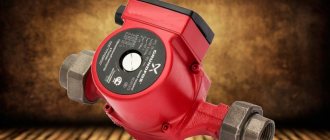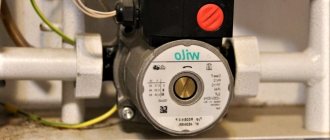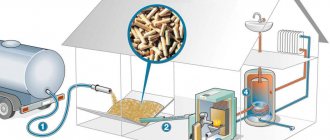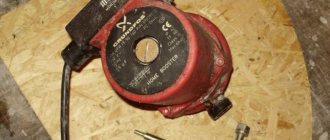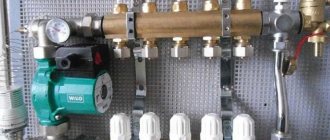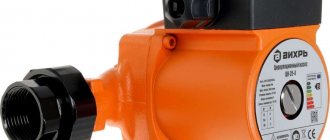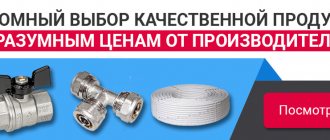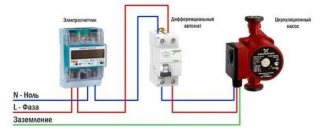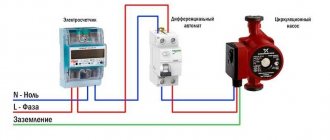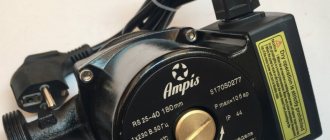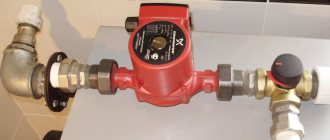The use of a circulation pump for heating systems significantly improves their performance characteristics. In addition, such pumps, thanks to which the water heated by the boiler enters all elements of the heating systems much faster and less cold, allow you to save on energy resources (electricity, fuel for the boiler). The effectiveness of using circulation pumps as part of heating systems largely depends on the correct choice of such equipment, made on the basis of its technical characteristics.
Heating circulation pumps
When is it necessary to install a circulation pump in a heating system?
The presence of a circulation pump in the heating system reduces the heating time of radiators to several minutes. It forcibly accelerates the coolant through the heating system, ensuring uniform circulation of hot liquid. The need to install it arises in cases where the natural circulation of the coolant cannot cope with heating the house.
Pumps are installed immediately when installing a heating system or during its modernization. Sometimes, errors in the design of heating systems are discovered only during operation.
The reason for poor heating of housing construction can be fouling of the internal walls of the system pipes with rust, scale or dirt.
This increases the hydraulic resistance in the heating system and deteriorates the circulation of the coolant in general in it or in certain areas. Installing a pump can help solve the problem of heating a home in such cases without completely replacing the heating system. The smooth operation of pumps depends on their correct installation.
About the importance of the brand
There are a great many names of circulation pumps, but this does not prevent them all from having almost identical characteristics. And if there are significant differences, they relate mainly to reliability and service life.
Wilo circulation pump
The most popular brands today are Grundfos, Speroni, Wilo, ELSO-THERM and Wester. In addition to them, there are a lot of outright Chinese counterfeits and more (meaning “real” Chinese goods). The brands we list are considered by consumers to be the highest quality and most reliable. Circulation pumps from well-known manufacturers are almost silent. You can make sure that the device is working only by touching it, or by ear, but from a distance of a few centimeters. They are durable and can serve you for many years, but have a significant drawback - high cost (it is almost twice as much as less popular models).
Other brands are a middle option. They work well, their prices are reasonable, and breakdowns are rare.
The opinions of all buyers about pumps from China agree: sooner or later the devices begin to make noise, the rotor begins to “walk”. Their service life sometimes reaches several years, but in most cases does not exceed several months. Naturally, they are inexpensive.
What are the benefits of installing circulation pumps in heating systems?
Modern pumps allow you to regulate the intensity of coolant supply in the system automatically. Maintaining a constant temperature in it protects system parts from premature wear, and the uniform movement of coolant through pipes and radiators increases the service life of the thermal unit and expansion tank.
Other advantages of installing circulation pumps in the heating system include:
- eliminating the possibility of air locks forming in the system;
- increasing the efficiency of the thermal boiler and reducing fuel consumption for heating the house;
- the possibility of installing heated towel rails and using small diameter pipes in the heating system.
Expert opinion
Grebnev Vadim Savelievich
Heating system installer
The main disadvantage of circulation pumps is their dependence on electricity. Interruptions in its supply can damage the devices.
FAQ
Will the pipes make noise when using the pump?
There can be noise in the pipes only if the device is chosen incorrectly or air has accumulated in the line. To remove air, do the following:
- fill the entire system with water;
- we remove air using valves on radiators - “air vents”;
- we start the heating boiler and pump;
- we wait for a while, after which we remove the air again;
- check the pressure, fill the circuit with water;
- we start the pump and adjust it (if it can be adjusted at all).
Is it possible to use a high pressure pump for water supply?
Definitely no! Even though they (pumps) look almost the same, in water supply pumping equipment is used solely to maintain the required pressure if for one reason or another it is not enough.
What are pumps made of?
Some parts (shaft, ball bearings) of modern pumps are made of ceramics. This not only ensures silent operation, but also significantly increases service life.
Are there pumps for hot water supply?
Yes, they exist. This is, for example, the GRUNDFOS Comfort UP circulation pump, thanks to which you don’t have to wait for hot water to start flowing from the tap. Of course, its use will increase the consumption of electricity and water itself.
How much energy do pumps consume?
In most cases, circulation pumps are extremely economical devices that consume as much energy as a regular light bulb. Recently, everything has been about assigning labels to products that indicate their “gluttony capacity,” as is the case with household appliances. A classification has been developed according to which A-class devices, for example, need no more than 6 W.
Note! Adjustable pumps are more economical!
How often do circulation pumps need to be replaced?
If the pump is of high quality, it will last about ten years. Although, as we have already said, a lot depends on the manufacturer itself. To ensure that your device lasts longer, follow all recommendations regarding operation: select the correct model and install it, avoid airing the line, use only specially purified water as a coolant.
Types, features
Centrifugal-type devices operate on the principle of fluid intake by an impeller and ejection in a given direction. They work with equal efficiency for suction and discharge. All circulation pumps used in heating systems are divided into two main groups: wet and dry rotor. Each type of device has its own design features.
Glandless Rotor Pumps
Equipment of this type is considered the most suitable for domestic heating systems due to the low noise level they create during operation. In their structure they are similar to drainage units. Externally, pumps with a wet rotor can be distinguished from dry designs by the absence of fins on the motor housing and the impeller at its end.
Their impeller is mounted directly on the motor shaft. Seals are placed on it to prevent leakage. The housing has a sealed design. For its manufacture use: brass, cast iron, bronze or stainless steel. The pump rotor is most often made of ceramic material. A special feature of the design is its direct contact with water.
Centrifugal force is created inside the pump. The rotating impeller reduces the pressure inside the device body. This causes an influx of fluid. It increases the pressure. The resulting temperature difference creates conditions for pushing the carrier into the system.
Among the advantages of pumps of this type:
- independent removal of air locks from the system;
- less wear on pump parts;
- self-cooling.
Dry rotor pumps
The device does not have direct contact with liquid. Pumps of this type have the highest efficiency. The structure is cooled using an air system. The main disadvantage of this type of equipment is the increased noise level during operation. Dry rotor circulation pumps are designed to work with large volumes of water. They are preferred when installed in the heating system of industrial facilities.
DAB
Circular pumps DAB and Aguario, located in the middle price segment, are in great demand on the product market.
The first device, subject to systematic prevention, works flawlessly. The company pays a lot of attention, and not without success, to reducing the noise level of dry-type pumps.
The best circulation pumps for heating systems
Grundfos UPS 25-40 180
Country of origin: Serbia. The model is one of the most popular and in demand. Installation method: horizontal and vertical. The unit has protection against overheating. Operating the pump for pumping heavily contaminated liquids is strictly prohibited. The operating temperature limit is from 2°C to 110°C. The unit operation setting is mechanical.
Characteristics:
- productivity – 2900 l/h;
- power consumption – 45 W;
- head – 3.8 m.
Advantages:
- high performance;
- affordable price;
- reliability;
- good pressure.
Flaws:
- more expensive than similar domestically produced devices;
- the model is often counterfeited.
"Whirlwind" TsN-25-4
Country of origin: Russia. The model is designed for pumping hot and cold liquids. Operating temperature range from -10°C to 110°C. The body of the product is made of cast iron. The optimal operating mode of the pump is selected using a special switch.
Characteristics:
- productivity – 50 l/min.;
- power consumption – 72 W;
- head – 4 m.
Advantages:
- low noise level;
- ease of installation and operation;
- long service life;
- affordable price;
- efficiency;
- compactness.
Main disadvantage
- discrepancy between the characteristics declared by the manufacturer and the actual ones.
Oasis CN 25/4
Country of origin: China. The model with a wet rotor is intended for installation in heating systems designed to heat rooms up to 100 sq.m. Installation method: horizontal. The body is made of cast iron, the rotor is ceramic. The model can be used to supply hot water and in underfloor heating systems.
Characteristics:
- productivity – 170 l/min;
- power consumption – 245 W;
- head – 8 m.
Advantages:
- efficiency;
- compactness;
- light weight;
- long service life;
- ease of installation and maintenance.
Flaws:
- not identified.
Grundfos UPS 25-60 180
Country of origin: Denmark. Model with wet rotor. Designed for installation in horizontal and vertical positions. There are requirements for the purity of the liquid. Can be used for heating and hot water supply systems. The product has a bronze body. The pump has 3 operating speeds, with which the pressure in the system is regulated.
Characteristics:
- productivity – 4.35 cubic meters/hour;
- power consumption – 60 W;
- head – 6 m.
Advantages:
- several rotor speeds;
- compactness;
- reliability;
- ease of installation and operation.
Flaws:
- not identified.
Grundfos ALPHA2 25-60 180
Country of origin: Denmark. The low-noise pump model has a high quality design. Designed for installation in heating systems of low-rise buildings. The model has two settings: manual and automatic. The device installation method is vertical.
Characteristics:
- productivity – 3 cubic meters/hour;
- power consumption – 45 W;
- head – 6 m.
Advantages:
- low noise level during operation;
- ease of installation and operation;
- reliability;
- long service life.
Main disadvantage:
- high price.
Valtec VRS 25/4 130
Country of origin: Russia. Model with wet rotor and three-stage speed switch. The body of the product is made of cast iron. Installation method: vertical and horizontal. The maximum operating temperature limit is 110°C. The rotor is cooled by the pumped liquid.
Characteristics:
- productivity – 3000 l/hour;
- power consumption – 72 W;
- head – 4.2 m.
Advantages:
- reliability of the design;
- affordable price;
- ease of installation and operation.
Main disadvantage:
- short standard power cord.
JEMIX WRF-50/12
Country of origin: Russia. Model with wet rotor. The pump has an aluminum single-speed motor. The product is intended for installation in heating systems of small cottages. The method of connection to the pipeline is flange. The pump is installed directly into the pipeline.
Characteristics:
- productivity – 9600 l/hour;
- power consumption – 550 W;
- head – 12 m.
Advantages:
- high pressure;
- reliability;
- high efficiency.
Flaws:
- the need to weld counter flanges to the pipeline;
- high price.
WWQ CN 25/60-180
Country of origin: Russia. Three-speed model with a wet ceramic rotor. The pump is designed for installation in the heating system of low-rise buildings.
Characteristics:
- productivity – 58 l./min.;
- power consumption – 90 W;
- head – 6 m.
Advantages:
- overheat protection;
- ease of maintenance and operation.
Main disadvantage:
- short network cable.
Wilo
High quality, as always, was considered the trademark of any German product. The Wilo Star RS 25/4 circulation pump is no exception.
Both consumers and experts note such advantages of the device as:
- ease of installation;
- reliability;
- fast connection;
- three power levels.
Another advantage of the installation is the absence of the need for systematic maintenance.
What to consider when choosing
The determining factor in choosing a circulation pump for a heating system is its performance. To pressurize large-diameter pipes, it is necessary to install units with high power. When installing pumps in a separate room, the temperature conditions of the equipment must be taken into account.
Other factors influencing the choice of circulation pumps for heating include:
- principle of operation;
- method of connection to the system;
- number of circuits.
When purchasing a pump, you should pay attention to the manufacturers' recommendations on room heating standards. These values differ depending on the country in which the unit is installed.
Expert opinion
Grebnev Vadim Savelievich
Heating system installer
The functionality of the devices is important. It is preferable to install pumps with automatic adjustment of operating modes in heating systems.
Advantages and disadvantages
Among the advantages the following can be noted:
- Heat is distributed evenly throughout the building , so all rooms have the same temperature. This avoids cases where large rooms are colder than small ones.
- The system can be adjusted.
- Automatic mode , thanks to which the pump operates continuously, or operates in the set mode.
- Functionality. The operating temperature range of the device is from +2ᵒС to +130ᵒС, so the pumps work with both water and ethylene glycol.
- Good pressure. When the system is given normal pressure, all adjacent equipment will work properly.
- Variety. Therefore, the pumps can be used for both small and large rooms.
The disadvantages include:
- The pump itself is inexpensive, but it consumes 40–80 watts of electricity around the clock, which is a considerable expense.
- The operation of the entire system directly depends on the supply of electricity. This problem can be avoided by installing, for example, a diesel generator in advance.
- There are additional costs for the purchase of taps, filters, etc., which actually increases the cost of the pump.
- Installing the device also costs money, but you can save on this if you do it yourself.
Calculation formulas
Without carrying out the calculations below, it is not possible to select the right pump, so this point is simply indispensable.
Productivity
This parameter in calculations is usually denoted by the letter Q and shows how much heat can be moved by the pump per unit time.
The formula looks like this:
Where:
- Q —volume flow, m 3 /h;
- R — required power for the room, kW;
- TF is the value of the liquid temperature at the system inlet, ᵒС;
- TR is the temperature of the liquid at the outlet of the system, ᵒС.
